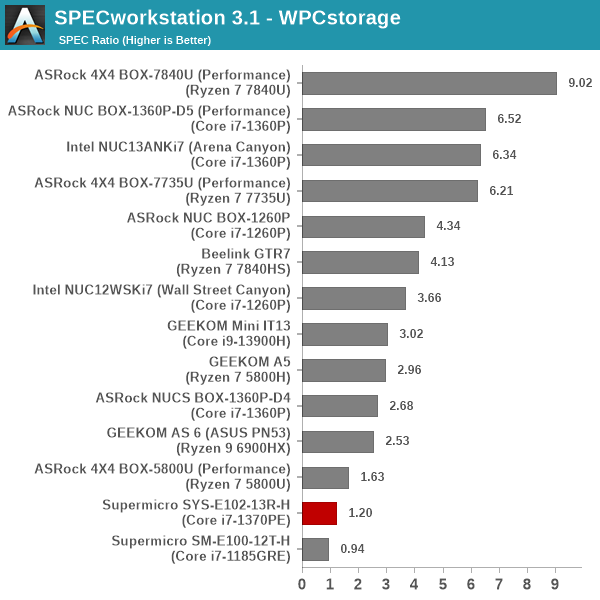Supermicro E102-13R-H Review: A Raptor Lake-P 3.5-inch SBC System for Embedded Applications
by Ganesh T S on May 14, 2024 8:00 AM EST- Posted in
- Systems
- Intel
- Embedded
- Supermicro
- Mini-PC
- Raptor Lake-P
Miscellaneous Aspects and Concluding Remarks
Networking and storage are aspects that may be of vital importance in specific PC use-cases. The Supermicro SYS-E102-13R-H comes with support for a M.2 2230 WLAN/BT card, as well as a nano SIM slot. Interested users can add their own solution for wireless connectivity. On the wired front, we have two NBASE-T ports (up to 2.5 Gbps each). From a management perspective, the CPU is vPro-enabled - AMT and native dual LAN support allows out-of-band management with a dedicated LAN port, if necessary.
On the storage side, some applications require wide-temperature range and/or high endurance SSDs. Our review sample of the Supermicro SYS-E102-13R-H came with a PCIe 3.0 x4 InnoDisk NVMe SSD. It is no match for the performance provided by the Gen 4 NVMe SSDs in other systems. From a benchmarking perspective, we provide results from the WPCstorage test of SPECworkstation 3.1. This benchmark replays access traces from various programs used in different verticals and compares the score against the one obtained with a 2017 SanDisk 512GB SATA SSD in the SPECworkstation 3.1 reference system.
| SPECworkstation 3.1.0 - WPCstorage SPEC Ratio Scores | |||

The graphs above present results for different verticals, as grouped by SPECworkstation 3.1. The storage workload consists of 60 subtests. Access traces from CFD solvers and programs such as Catia, Creo, and Soidworks come under 'Product Development'. Storage access traces from the NAMD and LAMMPS molecular dynamics simulator are under the 'Life Sciences' category. 'General Operations' includes access traces from 7-Zip and Mozilla programs. The 'Energy' category replays traces from the energy-02 SPECviewperf workload. The 'Media and Entertainment' vertical includes Handbrake, Maya, and 3dsmax. Given that the comparison is between a wide range of SSDs in the systems - including both Gen 3 and Gen 4 NVMe, as well as SSDs using DRAM for the flash translation layer, and others using either host memory buffer or operating in DRAM-less mode, the relative numbers for most workloads are not surprising. The InnoDisk Gen 3 drive in DRAM-less mode is rated for wide-temperature operation, but the benchmark numbers cut a sorry figure and leave the SYS-E102-13R-H towards the bottom of the pack. From an embedded PC perspective, the key aspect is the industrial rating / wide operating temperature range for the SSD itself. This ensures ability of the storage device to withstand operation in demanding environmental conditions.
Closing Thoughts
The Supermicro SYS-E102-13R-H provided us with the opportunity to evaluate a 3.5-inch SBC targeting embedded applications. The motherboard itself is loaded with plenty of features, but the chassis used to create the SYS-E102-13R-H has cut-outs only for the LAN ports and the built-in USB Type-A and Type-C ports. The Core i7-1370PE is an excellent processor with particularly impressive graphics performance for its configured PL1 value of 28 W. The system also supports four independent displays with its two HDMI ports and two Type-C ports. This opens up a wide variety of use-cases in the digital signage market. The single-threaded performance for the power budget is currently among the best in the embedded space.
The system comes with vPro / AMT support, enabling remote monitoring and administration. The power limits are conservatively configured at 28 W / 44 W, which is reasonable for an actively-cooled compact 3.5-inch SBC targeting the embedded market. It contributes to long-term product reliability.
In terms of scope for improvement, a different chassis with support for additional USB / COM ports (similar to the fanless Tiger Lake-based SM-E100-12T-H) could have opened up many additional use-cases. USB4 / 40 Gbps support in the Type-C ports (sourcing both from the native Thunderbolt ports in the processor) could have lent to additional differentiation. Obviously, USB4 (or, for that matter, even Type-C itself) has not yet taken off in the embedded market. Therefore, Supermicro's decision to limit the Type-C ports to 10 Gbps may be acceptable if there are cost-savings in the picture.
In terms of pricing, the barebones version is priced around $1000. This is par for the course for compact high-performance embedded PCs targeting the B2B market. Supermicro has a wide variety of such systems available for the IoT market segment. The SYS-E102-13R-H ticks all the right boxes. It is a solid offering for specific use-cases in applications such as IoT gateways, digital signage and kiosk duties, and edge computing.











1 Comments
View All Comments
sjkpublic@gmail.com - Wednesday, May 15, 2024 - link
No usb4? Max memory? I like that it has 3 M.2 slots. But if you use all 3 there may be a thermal issue?